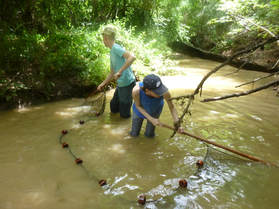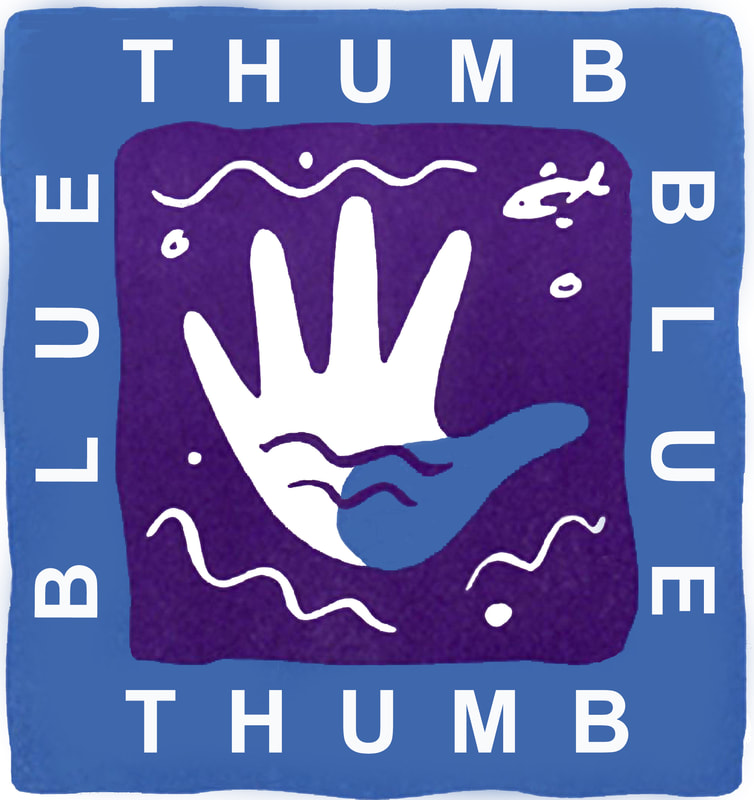 Volunteers seining in the tributary to the Arkansas River. Volunteers seining in the tributary to the Arkansas River. In previous blogs, I described the way we collect the bugs living at the bottom of the creek and the multi-day “fish school” that our staff members recently attended. What I learned at fish school is now invaluable during the summer months when we do another kind of collection: fish collections. Similar to the bug collections, we look for fish to find more information about how healthy a creek is. Certain kinds of bugs can tolerate pollution while others cannot. Fish are the same way; some can live in more polluted waters while others are not able to survive in those conditions. Every summer, the Blue Thumb staff conducts these fish collections in a designated area of the state, which rotates every four or five years. So, for example, if Oklahoma City creeks had collections this year, those creeks would not be fished again for another four years. This year, the primary area we are fishing is Cherokee County in the northeast, especially around the town of Tahlequah. This is an area with a lush, green natural environment, filled with trees, hills and creeks that run very clear through rural towns and over a creek bottom with lots of gravel and rocks. An exciting opportunity for contrast will be the few creeks we are also fishing in Lawton and Sulphur. We actually started this year’s fish collections in Muskogee, a much more urban environment than where most of this summer’s creeks will be found. This first creek, a tributary of the Arkansas River, runs through a residential area with a number of homes and has a close encounter with a nearby highway. When we arrived there, Kim, Jeri and I met up with Abigail Wright, our Blue Thumb volunteer who monitors the site as well as Sherry Davis, an intern working with the Conservation Commission for the summer. The collections always begin with a habitat assessment of the creek, with all of us walking 400 meters up the creek, taking note of many important factors, including bank vegetation, bank erosion, how deep the water is, what the creek bottom is made up of and what kind of habitat is available in the stream for aquatic organisms. After doing that, we return to the spot where the assessment ended and work our way back down the creek collecting fish. How exactly do we collect fish, you ask? While there are a number of ways that people can perform a fish collection, our collections with volunteers employ the use of a seine. A seine is “a fishing net that hangs vertically in the water, having floats at the upper edge and sinkers at the lower.” We typically use two of these, small and large, and choose one depending on the size and type of area we are seining. Kim leads the way, making decisions as we go along about which seine to use, which part of the stream to focus on, where to put the seine in, where to pull it up on the bank and other important steps along the way. One of the most important things to remember when seining is to keep that lower edge, the one with the sinkers, or “lead line,” on the bottom of the creek at all times. This way, fish can’t escape underneath the net as you’re moving forward. It’s also important to get the poles of the seine angled correctly, keeping the lead line end of the pole on the creek bottom, maintaining the right angle of the pole to keep the basket shape in the net and using the end of the pole to poke and prod banks of the creek to get the fish out of the roots and rocks that create habitat. Tributary to Arkansas collection was a lot of fun and gave us all a chance to encounter a number of fish as well as other wildlife, including a snake and turtle. Being in the creek on a hot summer day, especially when we were in areas with no canopy cover, gave me a good idea of what this kind of work can be like for those who do it all the time. It also provided a good contrast to the other creeks I would soon encounter, as this one was in a more urban setting, was more murky and more impacted by trash and human development than some of the creeks to come. Providing the starkest evidence of human impact was the long tunnel we had to seine through as it passed under the roadway above. Enough water ran through the tunnel that we were able to seine both sides of it and find evidence that even with that kind of concrete environment, organisms still live in the water there. For the fish collection as a whole, we found numerous sunfish (bluegill, longear and green) as well as mosquito fish and central stonerollers. For the second creek on our collection schedule, we travelled to Tahlequah. Cedar Hollow Creek feels about as far as you can get from an urban setting and human development. The creek is located in the J.T. Nickel Family and Nature Wildlife Preserve, owned by the Nature Conservancy. After we parked our vehicles and met up with Blue Thumb volunteers Gary and Irene Wickham, we walked into the woods to the monitoring site. Heading farther up the creek and deeper into the woods, the creek remained pretty shallow, just a trickle over the numerous rocks in many places. It’s a lovely and tranquil spot, very quiet, especially compared to being at a creek that runs along and under a highway. Even with the shallowness of the creek overall, there were some deeper pools that allowed for good seining and we found quite a few fish, including creek chub, orange throated darter and lots and lots of southern redbelly dace (there were many dace puns to be had all during the collection). More fish collections are happening and will continue over the next few weeks. Stay tuned for those stories. Same Blue Thumb time. Same Blue Thumb channel.
0 Comments
Your comment will be posted after it is approved.
Leave a Reply. |
The Blue Thumb Blog
Archives
July 2018
Categories
|


 RSS Feed
RSS Feed